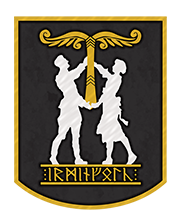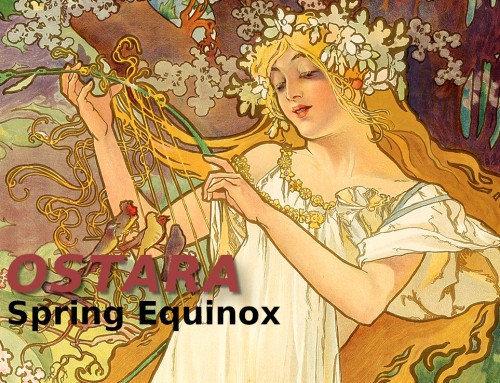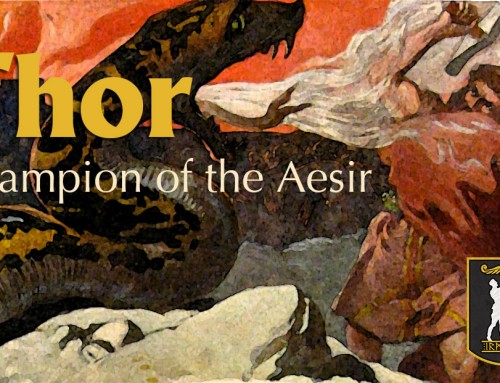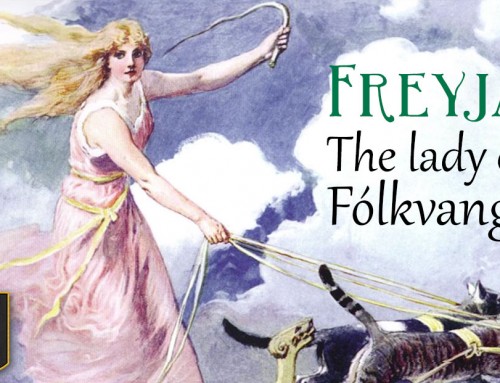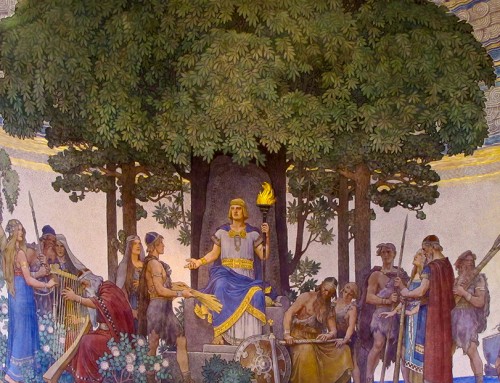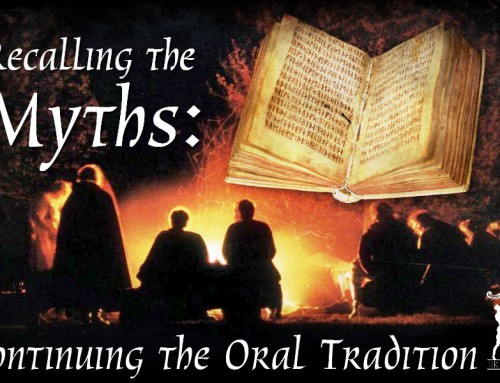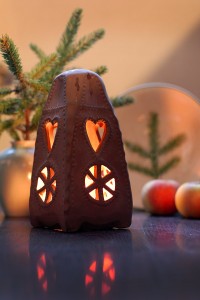

This Yule Leuchter was made by the Porzellan Manufaktur Allach from 1936-1945. Allach employed the best and finest porcelain craftsmen known in the German world. Today, this original can fetch upwards to $2,000 (US).
The Julleuchter or Yule Lantern is a small hollow clay candlestick about 8″ tall. On its four sides it has a heart and a Hagall rune. The Hagall Rune represents Faith and the heart represents the spirit or soul. It stands for an inseparable community, its conscious and attitude. There is a place both inside and on top of the Lantern for a candle to be placed; each position having a specific ceremonial meaning. The julleuchter is used in the seasonal rituals that occur on the Vernal Equinox, Mid-Summer, Autumnal Equinox, and Mid-Winter and in family traditions throughout the year. A traditional icon of the Germanische Irminnenschaft, it is virtually exclusive to Germanic Heathenry.
The ancient roots of the julleuchter was first mentioned in 1888 in the Swedish literary society’s journal Runa where the object is described as having origins in 16th century Holland. The article included a picture on page 22 of a specimen in a Holland museum.
In an article in the December 1936 issue of Germanien Magazine, the Millennium old lantern had been used as a memento of the “Year of the Great Migrations” of the people of the north and as the small light of humanity under the stars of the night sky. When used during the 2 Solstice periods of the year, this is a symbol of the victory of Light over the Darkness, and also as a token of Eternal Circulation. The Julleuchter stands for an inseparable community, its conscience and attitude, and that it was used as a symbol of never ending sunlight. Further, the magazine stated that when the Julleuchter was used during The 12 Days of Yule, twelve candles are used. One is used each night symbolizing the twelve months, until the 31 of December when the “July Moon shines.” On that night a thirteenth candle is used for the new coming month of January. The candles always burn below but on the last night, the candle is again transferred upward- this is the sun, which is spilled in order to return to the earth from the gloom of another peace.
A description of how and when the Julleuchter is used is given by Khaynrikh Shil’d in “Светильник Йоля”(Lamp of Yolya). The information about how the Julleuchter is used during the Winter Solstice is almost the same as the one given in the December 1936 Germanien magazine.
“We will start by stating that the year is divided into six equal spokes. For simplicity’s sake, we will call the first spoke the Ostara-fest, since this commences the “light half” of the year. Prior to the Blot itself, the Jul-leuchter is set with a candle at the Summit, as well as one underneath. At the beginning of the blot, we light the candle underneath by using a twig, which receives its flame from the stove – symbolic of the old Hearth Fire as the stove holds the family’s cooking fire. At the high point of the Blot, it becomes time to take the flame from the candle underneath and take it to the top candle. This sacred act is symbolic of the re-birth of the Sun, since we are now in the “light half” of the year (meaning that the Sun is commencing her ascent). For the next two festivals, the Midsummer-fest and the Harvest-fest, only a Summit candle is lit, as we are still in the “light half” of the year. The Winternights-fest is quite the opposite of the Ostara-fest. The Jul-leuchter is set with the candle underneath, and one on the Summit. As we are entering into the “dark half” of the year, we begin by lighting the Summit candle (from a flame taken from the stove). From this, we transfer the flame to the bottom candle. This symbolizes the death of the Sun – as she is in the decline, moving toward her “grave”. The Jul-fest is quite a special festival, and the use of the Jul-leuchter is a little different than the other festivals… The Winter Solstice is a time when the Sun is at her lowest, seemingly dead. So our late evening Jul-fest rite (held on the 21st December) uses the Jul-leuchter to help “re-awaken” her from her grave. As it is the “dark half” of the year because the hours of daylight are so short – we begin our rite by lighting the candle underneath the Jul-leuchter. This candle is the same candle we used at the past year’s Jul-fest, which sat on the Summit. We then take a small twig, and pass this through the heart or Hagal-rune on the North side of the Jul-leuchter. The purpose of this is to take the flame from the bottom candle, and transfer it to the top candle. This symbolizes the eternal return of the Sun. After this time, all go to bed and in the morning, all awaken and look to see if the Sun has arisen from her grave – if it is so, all say a prayer of greeting to her, and open gifts in her honor, and in the honor of our Gods and Goddesses, who have made it possible. Finally, we have the Disting-fest. This is another “dark half” festival, so only the candle underneath is lit.”

